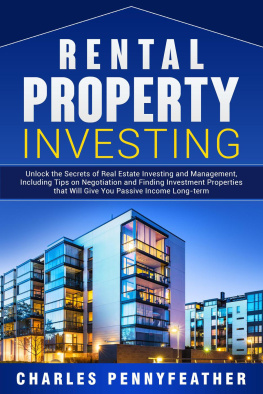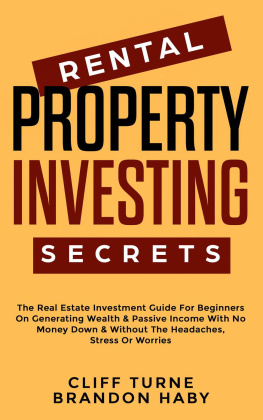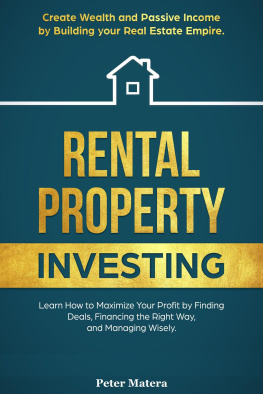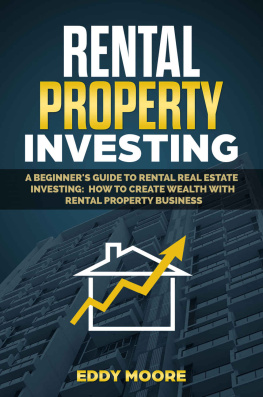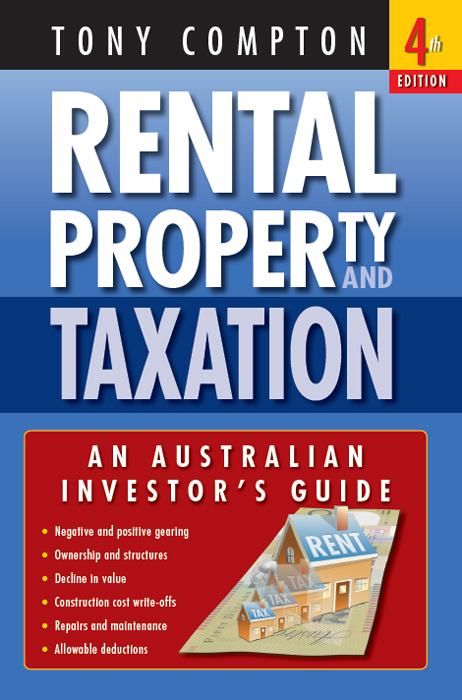Contents

Fourth edition first published 2008 by Wrightbooks,
an imprint of John Wiley & Sons Australia, Ltd
42 McDougall Street, Milton Qld 4064
Office also in Melbourne
Typeset in Baskerville 10/14pt
Tony Compton 2008 < www.tcompton.com >
The moral rights of the author have been asserted.
National Library of Australia Cataloguing-in-Publication Data:
Compton, Tony, 1951
Rental property and taxation : an Australian investors guide / Tony Compton. 4th ed.
9780731408481 (pbk.)
Includes index.
Real estate investment--Australia. Real estate investment--Taxation--Australia. Real estate investment--Australia--Finance.
332.63240994
All rights reserved. Except as permitted under the Australian Copyright Act 1968 (for example, a fair dealing for the purposes of study, research, criticism or review), no part of this book may be reproduced, stored in a retrieval system, communicated or transmitted in any form or by any means without prior written permission. All inquiries should be made to the publisher at the address above.
Acknowledgement: The author and publisher would like to thank the Commonwealth of Australia for kind permission to reproduce extracts from the Income Tax Assessment Act 1936 and the Income Tax Assessment Act 1997.
All legislative material herein is reproduced by permission but does not purport to be the official or authorised version. It is subject to Commonwealth of Australia copyright. The Copyright Act 1968 permits certain reproduction and publication of Commonwealth legislation. In particular, s.182A of the Act enables a complete copy to be made by or on behalf of a particular person. For reproduction or publication beyond that permitted by the Act, permission should be sought in writing. Requests should be addressed to the Manager, Copyright Services, Info Access, Department of Finance and Administration, GPO Box 1920, Canberra City, ACT 2601, or emailed to .
Nick Renton / Nick Renton. Reproduced with permission.
Cover design by Rob Cowpe
Disclaimer: The material in this publication is of the nature of general comment only, and neither purports nor intends to be advice. Readers should not act on the basis of any matter in this publication without considering (and if appropriate, taking) professional advice with due regard to their own particular circumstances. The author and publisher expressly disclaim all and any liability to any person, whether a purchaser of this publication or not, in respect of anything and of the consequences of anything done or omitted to be done by any such person in reliance, whether whole or partial, upon the whole or any part of the contents of this publication.
Preface
There have been many changes since the first edition of this book was written. The number of taxpayers owning rental properties has increased so much so that, according to Australian Tax Office (ATO) statistics, in 200405 1495645 tax returns were lodged that included gross rent as income. The boom in real estate has meant that capital gains tax has become a very real issue for those who decide to sell their properties. Many couples have paid the price of their short-term decision to invest in the higher income earning partners name.
Some things, however, remain the same. Real estate property companies continue to hawk rental properties in the various media. People continue to be invited to wealth-creation seminars where they learn how to become financially independent in a relatively short period of time. Telephone canvassers continue to phone at inopportune moments. Pamphlets arrive with other junk mail encouraging negative or positive gearing strategies. Figures are produced that may or may not stand the test of time. Misinformation abounds. For instance, one real estate companys internet site tells its readers once you have an investment property you will need to register for an Australian business number. If you want to claim input tax credits on the expenses you incur in running the investment, you will have to register for the GST as well. They are wrong on both counts.
People continue to make decisions that are tax-driven rather than investment-driven. In my experience, the majority of investors still do not understand the tax implications of their property investment. Many fail to appreciate that it is not enough for them to rely on their accountant to attend to their tax affairs. He or she can only work with the information provided and his or her understanding of the clients affairs. In a self-assessment environment it is important that taxpayers attempt to obtain some understanding of the tax laws as they apply to their own situations. This is a difficult task as Australias tax legislation is involved, complex and unwieldy, and nothing has happened that suggests to me that this will change. Nevertheless, property investors should make an attempt to be better informed about tax law as it relates to their investment/s.
Despite the governments promises of simplification, tax law continues to become even more complex. Different rules apply for depreciable assets purchased pre21 September 1999, between 21 September 1999 and before 1 January 2001, and after 1 January 2001. As well as this, pooling provisions have been introduced. Instead of presenting depreciation tables with percentage rates based on the effective lives, the Australian Taxation Office (ATO) has provided effective life tables requiring calculations based on the effective life and advisor of 100 or 200 depending on whether the depreciation method used is prime cost or diminishing value. The ATO instructs that the formula for calculating depreciation on an asset using the diminishing value method is:
Opening undeducted cost (days owned 365) 200 per cent of the effective life in years
What should be a simple matter has become more difficult, increasing the scope for error. Numerous changes, such as these, have been made since this book was first written. The changes are included in this new edition. Hopefully it will help non-accountants and non-lawyers obtain an understanding of the Australian taxation system as it relates to rental properties.
Tony Compton
Springwood, Qld
March 2008
Disclaimer
It is important that advice be sought from a competent taxation professional before acting on any information provided in this book. Tax laws change, and while every effort has been made to ensure the accuracy of the information herein at the time of writing, it is provided as a general guide only.
Chapter 1
The purchase
Ian and Marie are long-time clients of mine. They operate an earthmoving business, and up until now have lived year to year on an income from which they have saved little. One night, Ian received a phone call from a canvasser selling negatively geared investment properties. He and Marie had paid off their house (with the assistance of a small lottery win) and were interested in the idea of investing, so he agreed to meet with the caller.
As it turned out, the promoter was selling residential units in Chermside (a suburb on Brisbanes northside). Chermside is well serviced by transport, schools and shops, and is reasonably close to the city. He appeared genuine and the couples interest intensified.
That night, Ian and Marie made the decision to commence a journey into the investment world. Specifically, they decided to look into income-producing residential property.
I heard about it when they came in with their taxation records. They asked my advice, showed me the papers that they received from the investment company and told me they had signed a contract that was subject to finance. My clients knew little about investing, let alone investing in property. Further, they knew nothing about the effect of income tax on the investment. Nevertheless, they decided that they needed to provide for their retirement, and were disillusioned with the poor returns they had been achieving from their superannuation fund.



